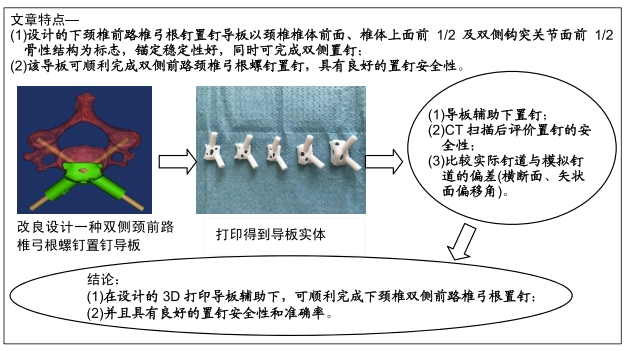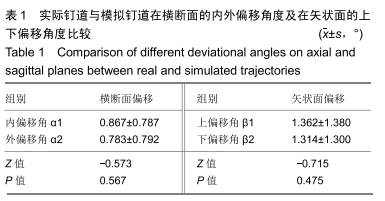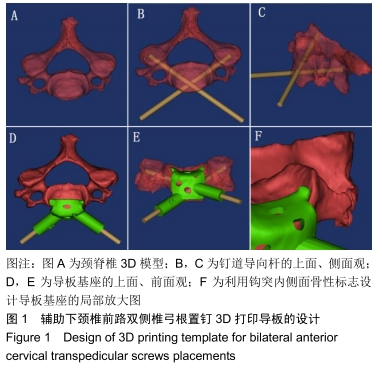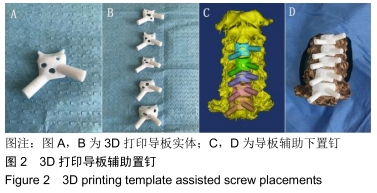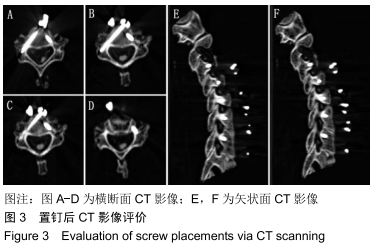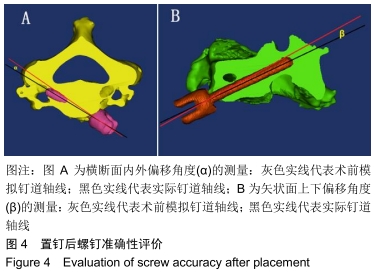[1] LIU X, MIN S, ZHANG H, et al. Anterior corpectomy versus posterior laminoplasty for multilevel cervical myelopathy: a systematic review and meta-analysis. Eur Spine J. 2014; 23(2):362-372.
[2] SMITH GW, ROBINSON RA. The treatment of certain cervical-spine disorders by anterior removal of the intervertebral disc and interbody fusion. J Bone Joint Surg Am. 1961;40-A(3):607-624.
[3] 吴海昊,汤涛,庞清江,等.下颈椎三柱损伤前路椎弓根螺钉内固定的生物力学研究[J].中华创伤骨科杂志,2017,19(10): 897-901.
[4] HAREL R, STYLIANOU P, KNOLLER N. Cervical spine surgery: approach-related complications. World Neurosurg. 2016;94:1-5.
[5] KOLLER H, HEMPFING A, ACOSTA F, et al. Cervical anterior transpedicular screw fixation. Part I: Study on morphological feasibility, indications, and technical prerequisites. Eur Spine J. 2008;17(4):523-538.
[6] KOLLER H, SCHMOELZ W, ZENNER J, et al. Construct stability of an instrumented 2-level cervical corpectomy model following fatigue testing: biomechanical comparison of circumferential antero-posterior instrumentation versus a novel anterior-only transpedicular screw-plate fixation technique. Eur Spine J. 2015;24(12):2848-2856.
[7] ZHANG YW, ZENG T, GAO WC, et al. Progress of the anterior transpedicular screw in lower cervical spine: a review. Med Sci Monit. 2019;25:6281-6290.
[8] PENG P, XU Y, ZHANG X, et al. Is a patient-specific drill template via a cortical bone trajectory safe in cervical anterior transpedicular insertion? J Orthop Surg Res. 2018; 13(1):1-7.
[9] WU W, CHEN C, NING J, et al. A novel anterior transpedicular screw artificial vertebral body system for lower cervical spine fixation: a finite element study. J Biomech Eng. 2017;139(6):23-28
[10] LI F, HUANG X, WANG K, et al. Preparation and assessment of an individualized navigation template for lower cervical anterior transpedicular screw insertion using a three-dimensional printing technique. Spine (Phila Pa 1976). 2018;43(6):E348-E356.
[11] 盛晓磊,袁峰,李智多,等.3D打印组合式导板辅助下颈椎前路椎弓根螺钉置入与徒手置钉的准确性对比[J].中国组织工程研究, 2017,21(3):406-411.
[12] LI J, ZHAO L, LIU W, et al. Anterior transpedicular screws in conjunction with plate fixation and fusion for the treatment of subaxial cervical spine diseases. Eur Spine J. 2015;24(8): 1681-1690.
[13] FU M, LIN L, KONG X, et al. Construction and accuracy assessment of patient-specific biocompatible drill template for cervical anterior transpedicular screw (ATPS) insertion: an in vitro study. PLoS One. 2013;8(1):e53580.
[14] 欧阳钧,吴卫东.颈椎前路椎弓根螺钉内固定技术的研究进展[J].暨南大学学报(自然科学与医学版),2013,34(4):367-372.
[15] 刘琨,赵汝岗,张强. 3D打印技术在骨科的应用研究进展[J].中华创伤骨科杂志,2015,17(1):63-66.
[16] 裴国献. 3D打印技术:骨科最新冲击波[J].中华创伤骨科杂志, 2015,17(1):8-9.
[17] LEE SH, KIM KT, SUK KS, et al. Assessment of pedicle perforation by the cervical pedicle screw placement using plain radiographs: a comparison with computed tomography. Spine (Phila Pa 1976). 2012;37(4):280-285.
[18] BAILEY RW, BADGLEY CE. Stabilization of the cervical spine by anterior fusion. J Bone Joint Surg Am. 1960;42-A:565-594.
[19] QIN R, SUN W, QIAN B, et al. Anterior cervical corpectomy and fusion versus posterior laminoplasty for cervical oppressive myelopathy secondary to ossification of the posterior longitudinal ligament: a meta-analysis. Orthopedics. 2019;42(3):e309-e316.
[20] XU L, SUN H, LI Z, et al. Anterior cervical discectomy and fusion versus posterior laminoplasty for multilevel cervical myelopathy: A meta-analysis. Int J Surg. 2017;48:247-253.
[21] LIU WJ, HU L, CHOU PH, et al. Comparison of anterior cervical discectomy and fusion versus posterior cervical foraminotomy in the treatment of cervical radiculopathy: a systematic review. Orthop Surg. 2016;8(4):425-431.
[22] YOUSSEF JA, HEINER AD, MONTGOMERY JR, et al. Outcomes of posterior cervical fusion and decompression: a systematic review and meta-analysis. Spine J. 2019;19(10): 1714-1729.
[23] KONIG SA, SPETZGER U. Surgical management of cervical spondylotic myelopathy - indications for anterior, posterior or combined procedures for decompression and stabilisation. Acta Neurochir (Wien). 2014;156(2):253-258, 258.
[24] CACCIOLA F, LIPPA L. Complications in the anterior approach to the cervical spine: Which factors matter? Int J Surg. 2017;45:160-161.
[25] HAREL R, STYLIANOU P, KNOLLER N. Cervical spine surgery: approach-related complications. World Neurosurg. 2016;94:1-5.
[26] KOLLER H, ACOSTA F, TAUBER M, et al. Cervical anterior transpedicular screw fixation (ATPS)--Part II. Accuracy of manual insertion and pull-out strength of ATPS. Eur Spine J. 2008;17(4):539-555.
[27] WU C, CHEN C, WU W, et al. Biomechanical analysis of differential pull-out strengths of bone screws using cervical anterior transpedicular technique in normal and osteoporotic cervical cadaveric spines. Spine. 2015;40(1):E1-E8.
[28] KOKTEKIR E, TOKTAS ZO, SEKER A, et al. Anterior transpedicular screw fixation of cervical spine: Is it safe? Morphological feasibility, technical properties, and accuracy of manual insertion. J Neurosurg Spine. 2015;22(6):596-604.
[29] YUKAWA Y, KATO F, ITO K, et al. Anterior cervical pedicle screw and plate fixation using fluoroscope-assisted pedicle axis view imaging: a preliminary report of a new cervical reconstruction technique. Eur Spine J. 2009;18(6):911-916.
[30] IKENAGA M, MUKAIDA M, NAGAHARA R, et al. Anterior cervical reconstruction with pedicle screws after a 4-level corpectomy. Spine (Phila Pa 1976). 2012;37(15):E927-E930.
[31] KOLLER H, HITZL W, ACOSTA F, et al. In vitro study of accuracy of cervical pedicle screw insertion using an electronic conductivity device (ATPS part III). Eur Spine J. 2009;18(9):1300-1313.
[32] BREDOW J, MEYER C, SIEDEK F, et al. Accuracy of 3D fluoro-navigated anterior transpedicular screws in the subaxial cervical spine: an experimental study on human specimens. Eur Spine J. 2017;26(11):2934-2940.
[33] 鲍立杰,张志平,吴培斌.3D打印技术在骨科的研究及应用进展[J].中国矫形外科杂志,2015,23(4):325-327.
[34] CAI H, LIU Z, WEI F, et al. 3D printing in spine surgery. Adv Exp Med Biol. 2018;1093:345-359.
[35] FENG ZH, LI XB, PHAN K, et al. Design of a 3D navigation template to guide the screw trajectory in spine: a step-by-step approach using Mimics and 3-Matic software. J Spine Surg. 2018;4(3):645-653.
[36] WU AM, LIN JL, KWAN K, et al. 3D-printing techniques in spine surgery: the future prospects and current challenges. Expert Rev Med Devices. 2018;15(6):399-401.
[37] 中华医学会医学工程学分会数字骨科学组,国际矫形与创伤外科学会(SICOT),中国部数字骨科学组. 3D打印骨科手术导板技术标准专家共识[J].中华创伤骨科杂志,2019,21(1):6-9.
[38] 吴晓宇,董谢平,吴彦超,等. 3D打印颈椎前路椎弓根螺钉导板的准确性评估[J].中国矫形外科杂志,2018,26(6):538-542.
[39] 王力冉,赵刘军,顾勇杰,等.改良版颈椎前路椎弓根螺钉导航模板的可行性研究[J].中华创伤骨科杂志,2018,20(6):504-509.
[40] 谭海涛,谢兆林,江建中,等.数字化导航模板在颈椎椎弓根螺钉置入中的应用[J].中国脊柱脊髓杂志,2015,25(6):497-502
[41] KARAIKOVIC EE, DAUBS MD, MADSEN RW, et al. Morphologic characteristics of human cervical pedicles. Spine (Phila Pa 1976). 1997;22(5):493-500.
|
